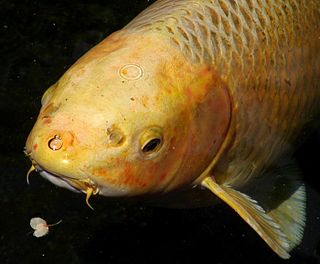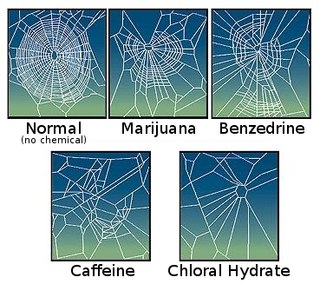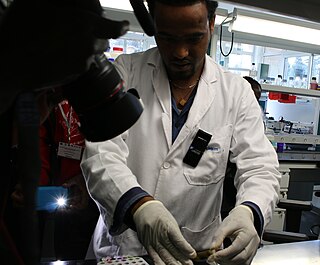
The zebrafish is a freshwater fish belonging to the minnow family (Cyprinidae) of the order Cypriniformes. Native to South Asia, it is a popular aquarium fish, frequently sold under the trade name zebra danio. It is also found in private ponds.

The GloFish is a patented and trademarked brand of fluorescently colored genetically modified fish. They have been created from several different species of fish: zebrafish were the first GloFish available in pet stores, and recently tetra, tiger barbs, Rainbow Shark, Siamese fighting fish, and most recently Bronze corydoras have been added to the lineup. They are sold in many colors, trademarked as "Starfire Red", "Moonrise Pink", "Sunburst Orange", "Electric Green", "Cosmic Blue", and "Galactic Purple", although not all species are available in all colors. Although not originally developed for the ornamental fish trade, it is one of the first genetically modified animals to become publicly available. The rights to GloFish are owned by Spectrum Brands, Inc., which purchased GloFish from Yorktown Technologies, the original developer of GloFish, in May 2017.
Segmentation in biology is the division of some animal and plant body plans into a series of repetitive segments. This article focuses on the segmentation of animal body plans, specifically using the examples of the taxa Arthropoda, Chordata, and Annelida. These three groups form segments by using a "growth zone" to direct and define the segments. While all three have a generally segmented body plan and use a growth zone, they use different mechanisms for generating this patterning. Even within these groups, different organisms have different mechanisms for segmenting the body. Segmentation of the body plan is important for allowing free movement and development of certain body parts. It also allows for regeneration in specific individuals.

A Morpholino, also known as a Morpholino oligomer and as a phosphorodiamidate Morpholino oligomer (PMO), is a type of oligomer molecule used in molecular biology to modify gene expression. Its molecular structure contains DNA bases attached to a backbone of methylenemorpholine rings linked through phosphorodiamidate groups. Morpholinos block access of other molecules to small specific sequences of the base-pairing surfaces of ribonucleic acid (RNA). Morpholinos are used as research tools for reverse genetics by knocking down gene function.
(Positive) Rheotaxis is a form of taxis seen in many aquatic organisms, e.g., fish, whereby they will (generally) turn to face into an oncoming current. In a flowing stream, this behavior leads them to hold their position rather than being swept downstream by the current. Rheotaxis has been noted in zebrafish and other species, and is found in most major aquatic invertebrate groups. Rheotaxis is important for animal survival because the positioning of an animal in the water can increase its chance of accessing food and lower the amount of energy it spends, especially when it remains stationary. Some organisms such as eels will exhibit negative rheotaxis where they will turn away from and avoid oncoming currents. This action is a part of their tendency to want to migrate. Some zooplankton also exhibit positive or negative rheotaxis.

In fish anatomy and turtle anatomy, a barbel is a slender, whiskerlike sensory organ near the mouth. Fish that have barbels include the catfish, the carp, the goatfish, the hagfish, the sturgeon, the zebrafish, the black dragonfish and some species of shark such as the sawshark. Barbels house the taste buds of such fish and are used to search for food in murky water.

The development of fishes is unique in some specific aspects compared to the development of other animals.

The Zebrafish Information Network is an online biological database of information about the zebrafish. The zebrafish is a widely used model organism for genetic, genomic, and developmental studies, and ZFIN provides an integrated interface for querying and displaying the large volume of data generated by this research. To facilitate use of the zebrafish as a model of human biology, ZFIN links these data to corresponding information about other model organisms and to human disease databases. Abundant links to external sequence databases and to genome browsers are included. Gene product, gene expression, and phenotype data are annotated with terms from biomedical ontologies. ZFIN is based at the University of Oregon in the United States, with funding provided by the National Institutes of Health (NIH).

Bisphenol S (BPS) is an organic compound with the formula (HOC6H4)2SO2. It has two phenol functional groups on either side of a sulfonyl group. It is commonly used in curing fast-drying epoxy resin adhesives. It is classified as a bisphenol, and a close molecular analog of bisphenol A (BPA). BPS differentiates from BPA by possessing a sulfone group (SO2) as the central linker of the molecule instead of a dimethylmethylene group (C 2), which is the case of bisphenol A.

Diisononyl phthalate (DINP) is a phthalate used as a plasticizer. DINP is typically a mixture of chemical compounds consisting of various isononyl esters of phthalic acid, and is commonly used in a large variety of plastic items.

The Genome Reference Consortium (GRC) is an international collective of academic and research institutes with expertise in genome mapping, sequencing, and informatics, formed to improve the representation of reference genomes. At the time the human reference was initially described, it was clear that some regions were recalcitrant to analysis with existing technology, leaving gaps in the known sequence. The main reason for improving the reference assemblies are that they are the cornerstones upon which all whole genome studies are based.

Psychoactive drugs, such as caffeine, amphetamine, mescaline, lysergic acid diethylamide (LSD), marijuana, chloral hydrate, theophylline, IBMX and others, can have strong effects on certain animals. It is believed that plants developed caffeine as a chemical defense against insects.

Genetically modified fish are organisms from the taxonomic clade which includes the classes Agnatha, Chondrichthyes and Osteichthyes whose genetic material (DNA) has been altered using genetic engineering techniques. In most cases, the aim is to introduce a new trait to the fish which does not occur naturally in the species, i.e. transgenesis.

A geneticist is a biologist or physician who studies genetics, the science of genes, heredity, and variation of organisms. A geneticist can be employed as a scientist or a lecturer. Geneticists may perform general research on genetic processes or develop genetic technologies to aid in the pharmaceutical or and agriculture industries. Some geneticists perform experiments in model organisms such as Drosophila, C. elegans, zebrafish, rodents or humans and analyze data to interpret the inheritance of biological traits. A basic science geneticist is a scientist who usually has earned a PhD in genetics and undertakes research and/or lectures in the field. A medical geneticist is a physician who has been trained in medical genetics as a specialization and evaluates, diagnoses, and manages patients with hereditary conditions or congenital malformations; and provides genetic risk calculations and mutation analysis.

Retinal homeobox protein Rx also known as retina and anterior neural fold homeobox is a protein that in humans is encoded by the RAX gene. The RAX gene is located on chromosome 18 in humans, mice, and rats.

Pelvic fins or ventral fins are paired fins located on the ventral surface of fish. The paired pelvic fins are homologous to the hindlimbs of tetrapods.
Brain-specific Homeobox is a protein that in humans is encoded by the BSX gene.
The Cyp11c1 is a fish gene encoding a CYP450 enzyme, which was originally found in Zebrafish, this enzyme mainly catalyze the formation of cortisol and 11-Ketotestosterone (11-KT). 11-KT is the endogenous androgen in zebrafish. CYP11C is the orthologous to CYP11B, tetrapod's CYP11B1 evolved from CYP11C1 of fish, and CYP11B/11C are the ohonologues to CYP11A, which duplicated during 2R event.
The Cyp11a2 is a fish gene encoding a CYP450 monooxygenase, which was originally identified in Zebrafish, is the isozyme and paralogous of fish CYP11A1, catalyzes conversion of cholesterol to pregnenolone.
Vatsala Thirumalai is a scientist at Neural Circuits and Development Laboratory, National Centre for Biological Sciences, Tata Institute of Fundamental Research, Bengaluru. She secured B Tech degree in biotechnology from Anna University, Chennai and PhD degree in neuroscience from Brandeis University, Waltham, MA. She was a Post-Doctoral Fellow at Cold Spring Harbor Laboratory, Cold Spring Harbor, NY and the National Institutes of Health, Bethesda, MD.













